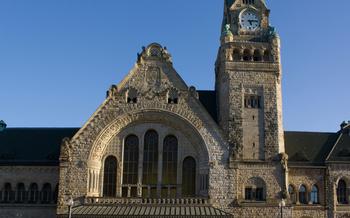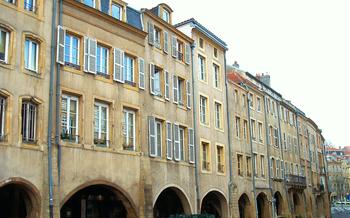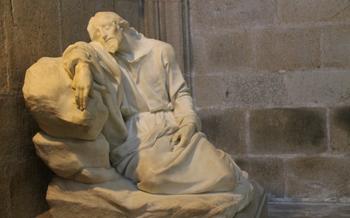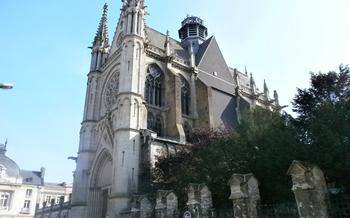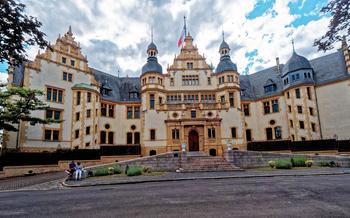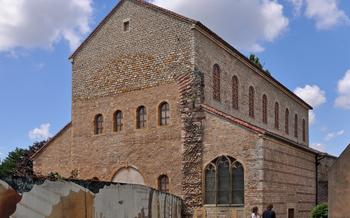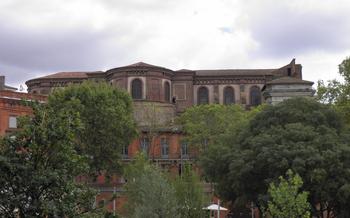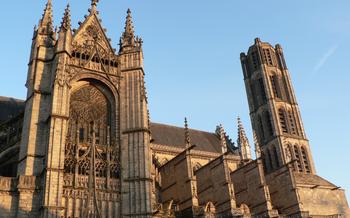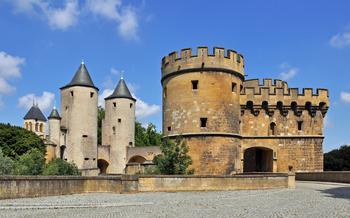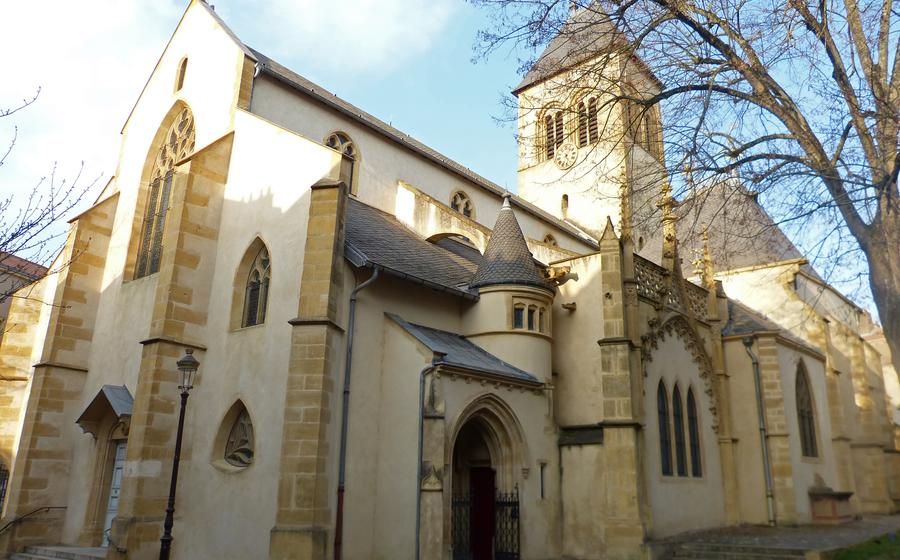
Église Saint Eucaire
- Location
- Opening Hours and Admission
- Guided Tours
- Highlights
- Architectural Style
- Stained Glass Windows
- Organs
- Bell Tower
- Religious Significance
- Cultural Events
- Nearby Attractions
- Practical Tips
- Insider Tip
Location
The Église Saint Eucaire is conveniently situated in the heart of Metz's old town, along the charming Rue des Clercs. This picturesque neighborhood, known for its medieval architecture and cobblestone streets, offers a glimpse into the city's rich history. The church is just steps away from other notable landmarks, such as the Place Saint-Louis and the Porte des Allemands, making it an ideal starting point for exploring the city's many attractions.
The church is easily accessible by public transportation, with several bus lines stopping nearby. The nearest train station, Metz-Ville, is approximately a 15-minute walk away. For those arriving by car, there are numerous paid parking lots within a short distance of the church.
Opening Hours and Admission
The Église Saint Eucaire welcomes visitors with open doors during specific hours, allowing them to explore its grandeur and rich history. Regular opening hours are typically from 9:00 AM to 12:00 PM and from 2:00 PM to 6:00 PM, providing ample time for exploration. However, it's advisable to check the church's official website or contact the local tourism office for any variations or special hours, especially during holidays or events.
Admission to the Église Saint Eucaire is generally free of charge, allowing visitors to experience its beauty without any financial barriers. This free entry policy encourages individuals from all backgrounds to appreciate and learn from the church's historical and artistic significance.
Guided Tours
Guided tours of the Église Saint Eucaire are available for visitors who want to learn more about its history, architecture, and religious significance. These tours are typically conducted by knowledgeable guides who can provide insights into the church's unique features and answer any questions that visitors may have.
Availability
Guided tours are available on a daily basis, except for major holidays. Tours typically last for about an hour and are offered in a variety of languages, including French, English, German, and Spanish. Visitors are advised to book their tours in advance, especially during peak tourist season.
Languages
Guided tours are available in a variety of languages, including French, English, German, and Spanish. Visitors can choose the language that they are most comfortable with when booking their tour.
Prices
The price of a guided tour of the Église Saint Eucaire varies depending on the language and the number of people in the group. Prices typically range from €5 to €10 per person. Visitors can book their tours online or through the church office.
Highlights
The Église Saint Eucaire boasts a wealth of remarkable features that captivate visitors from all corners of the globe.
-
Notable Features: Marvel at the intricate stained-glass windows, each a masterpiece of artistry, depicting biblical scenes and the lives of saints with vibrant colors and exquisite detail. The organs, renowned for their rich and harmonious sound, fill the air with celestial melodies. Ascend the bell tower, an architectural marvel that offers breathtaking panoramic views of Metz and its surroundings.
-
Must-See Attractions: Don't miss the Chapel of the Virgin, a stunning example of Gothic architecture, adorned with delicate sculptures and intricate carvings. The crypt, with its ancient frescoes and relics, provides a glimpse into the church's rich history.
-
Unique Experiences: Immerse yourself in the sound and light show, a mesmerizing spectacle that brings the church's history to life through captivating projections and enchanting music. Attend a classical concert, where the acoustics of the church create an unforgettable musical experience.
Architectural Style
The Église Saint-Eucaire is a masterpiece of Gothic architecture, exemplifying the transition from Romanesque to Gothic styles. Its construction began in the 13th century, and it incorporates elements of both periods.
The Gothic features are evident in the pointed arches, ribbed vaults, and flying buttresses. These elements create a sense of height and lightness, characteristic of Gothic architecture. The Romanesque influences are visible in the rounded arches and massive pillars, which lend the church a sense of solidity and strength.
Notable features of the church's architecture include the ornate facade, with its intricate carvings and sculptures, and the soaring bell tower, which offers panoramic views of the city. The interior of the church is equally impressive, with its vaulted ceilings, stained-glass windows, and elegant furnishings.
Stained Glass Windows
The Église Saint Eucaire is renowned for its magnificent stained glass windows, which adorn the interior of the church with vibrant colors and intricate designs. These windows date back to the 13th century and depict a variety of biblical scenes, historical events, and allegorical figures. The oldest windows, located in the choir, feature a series of medallions depicting scenes from the life of Christ. The windows in the nave, created in the 14th century, showcase a more diverse range of subjects, including scenes from the Old Testament, the lives of the saints, and the history of Metz.
The stained glass windows of the Église Saint Eucaire are not only beautiful works of art but also hold great historical and religious significance. They offer a glimpse into the beliefs and values of the medieval period and serve as a reminder of the enduring power of faith. Visitors to the church can spend hours admiring the intricate details and symbolism of these magnificent windows, which cast a warm and colorful glow throughout the interior.
Organs
The Église Saint-Eucaire boasts two impressive organs, each with its own unique history and musical significance. The Grand Organ, located in the choir loft, was built by renowned organ builder Aristide Cavaillé-Coll in 185It is a magnificent instrument with 49 speaking stops, three manuals, and a pedalboard. The Grand Organ is renowned for its rich and powerful sound, and it is often used for concerts and recitals.
The Choir Organ, situated in the choir gallery, was constructed by Mutin-Cavaillé-Coll in 1890. It is a smaller organ with 23 stops and two manuals. The Choir Organ is used to accompany the choir during liturgical services, and it also serves as a continuo instrument for small ensembles.
Both organs have been meticulously maintained and restored over the years, and they continue to play an important role in the musical life of the church. Visitors can often hear the organs being played during Mass, concerts, or recitals, and they are a testament to the rich musical heritage of the Église Saint-Eucaire.
Bell Tower
The imposing bell tower of the Église Saint Eucaire is a remarkable landmark that dominates the Metz skyline. Standing at an impressive height of 65 meters, it is one of the tallest bell towers in the region.
The tower was constructed during the 14th century, and its design reflects the transition from Romanesque to Gothic architecture. The lower section of the tower is characterized by its thick walls and narrow windows, typical of Romanesque architecture. As the tower rises, it transitions to a more Gothic style, with its intricate carvings, flying buttresses, and delicate pinnacles.
The bell tower is home to a set of bells that are renowned for their rich and harmonious sound. The largest bell, known as the "Bourdon de Saint Eucaire," weighs an astonishing 8 tons and is one of the largest bells in France. Visitors are welcome to climb the 300 steps to the top of the tower, where they are rewarded with breathtaking panoramic views of Metz and the surrounding countryside.
Religious Significance
The Église Saint Eucaire holds great religious significance as a prominent Catholic church in Metz. Dedicated to Saint Eucaire, the first bishop of Metz, the church serves as a place of worship and pilgrimage for the local Catholic community. The church's history and architecture reflect the strong Catholic traditions that have shaped the city of Metz over the centuries.
The Église Saint Eucaire is dedicated to Saint Eucaire, the first bishop of Metz. According to legend, Saint Eucaire was sent by Saint Peter to spread Christianity in the region. He arrived in Metz in the 3rd century and quickly converted many people to Christianity. Saint Eucaire is considered the patron saint of Metz and is revered by the local Catholic community.
The church is also a popular pilgrimage site, attracting visitors from near and far who come to pay their respects to Saint Eucaire and seek his intercession. Pilgrims often leave offerings and prayers at the church's altar, hoping for miracles and blessings. The church's spiritual atmosphere and the presence of Saint Eucaire's relics make it a place of great devotion and religious significance.
Throughout its history, the Église Saint Eucaire has played an important role in the religious life of Metz. It has been a place where Catholics have gathered to celebrate mass, receive sacraments, and seek spiritual guidance. The church has also been a witness to many important historical events, such as the coronation of Charlemagne as King of the Franks in 800 AD. Today, the Église Saint Eucaire continues to be a vibrant and active Catholic church, serving the spiritual needs of the local community and welcoming visitors from all over the world.
Cultural Events
The Église Saint Eucaire is not only a place of worship but also a venue for various cultural events. The church's impressive acoustics and beautiful interiors make it an ideal setting for concerts, recitals, and exhibitions.
Throughout the year, the church hosts a range of musical performances, including classical, sacred, and contemporary music concerts. Renowned musicians and choirs from around the world grace the stage of the Église Saint Eucaire, offering visitors a unique and enriching musical experience.
In addition to concerts, the church also hosts art exhibitions and displays. Local and international artists showcase their works within the church's historic walls, creating a fusion of art and spirituality. These exhibitions provide visitors with an opportunity to appreciate the diverse artistic talents and explore the rich cultural heritage of the region.
During the festive season, the Église Saint Eucaire transforms into a magical venue for special events and celebrations. Christmas concerts, nativity scenes, and traditional holiday services fill the church with joy and cheer. The annual Saint Eucaire Festival, held in honor of the church's patron saint, is a highlight of the cultural calendar, featuring processions, music, and lively festivities.
Nearby Attractions
Place de la Comédie
Just a short walk from the Église Saint Eucaire, you'll find the lively Place de la Comédie, the heart of Metz's cultural scene. The square is dominated by the magnificent Opéra-Théâtre de Metz, a 19th-century architectural masterpiece that hosts a variety of performances throughout the year. Be sure to admire the intricate facade and opulent interiors of this grand building.
Musée de la Cour d'Or
If you're interested in history and art, don't miss the Musée de la Cour d'Or, located just a few minutes' walk from the Église Saint Eucaire. This museum houses a vast collection of artifacts from Metz's rich past, including Gallo-Roman mosaics, medieval sculptures, and Renaissance paintings. The museum also has a section dedicated to the history of the city's Jewish community.
Centre Pompidou-Metz
For a taste of contemporary art, visit the Centre Pompidou-Metz, located on the banks of the Moselle River. This modern art museum is home to a rotating collection of works from the Centre Pompidou in Paris, as well as temporary exhibitions. The building itself is a work of art, with its distinctive, translucent roof and colorful exterior.
Marché Couvert
If you're looking for a taste of local flavors, head to the Marché Couvert, a bustling indoor market located near the Église Saint Eucaire. This market offers a wide variety of fresh produce, meats, cheeses, and other local specialties. Be sure to try the region's famous mirabelle plums, which are used to make a variety of jams, tarts, and liqueurs.
Practical Tips
Dress code: As a place of worship, visitors to the Église Saint Eucaire are expected to dress respectfully. While there is no strict dress code, it is advisable to avoid overly revealing or casual clothing.
Photography guidelines: Photography is generally allowed inside the church, but visitors are asked to be respectful and avoid using flash or tripods. It is also important to refrain from taking photos during religious services or ceremonies.
Accessibility for disabled visitors: The church is wheelchair accessible, with ramps and elevators providing access to all levels. Visitors with disabilities can also request assistance from the church staff if needed.
Insider Tip
Best time to visit
The Église Saint-Eucaire is a popular destination for tourists and pilgrims alike, so it can get quite crowded during peak season. If you want to avoid the crowds, it is best to visit during the shoulder seasons (April-May or September-October) when the weather is still mild but there are fewer visitors.
Hidden gem or lesser-known feature
One lesser-known feature of the Église Saint-Eucaire is the crypt, which is located beneath the church. The crypt houses the remains of several important religious figures, including Saint Eucaire himself. It is a fascinating and atmospheric space that is well worth a visit.
Unique photo spot
For a unique photo of the Église Saint-Eucaire, head to the Place Saint-Louis, which is located just a short walk from the church. From here, you can get a great view of the church's façade, with the Place Saint-Louis's fountain and statue of Louis XIII in the foreground.
